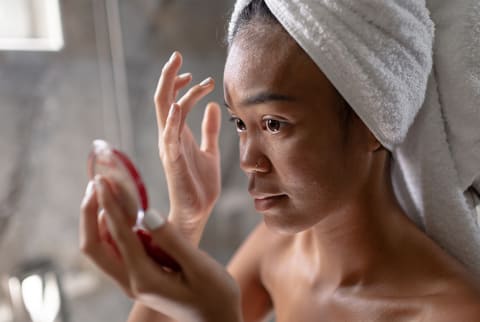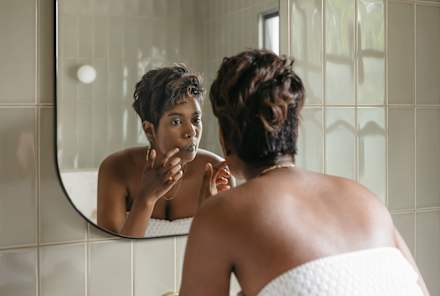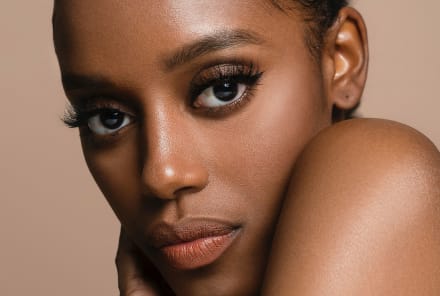Advertisement
How To Get Rid Of A Pimple Trapped Under The Skin, From Experts


We think it's safe to say that no one is ever excited about the appearance of a pimple. Sure, we know a zit here or there is inevitable, but never, ever are they welcome. Whiteheads are annoying, but under-the-skin pimples have them beat. Under-the-skin pimples, otherwise known as blind pimples, are exactly what you think—a pimple that stays under the skin.
And while that may sound like a better option than an unsightly whitehead, they are a bit trickier to prevent and treat. Not to mention, they can become inflamed and sore to the touch if not treated properly.
Thankfully, we tapped dermatologists to get the scoop on under-the-skin pimples so we can tackle them once and for all. And the best part is, this type of breakout can be easily treated at home, even using ingredients from your pantry.
Keep reading to learn what under-the-skin pimples are, what causes them, and how to treat them asap.
What is a pimple under the skin?
According to board-certified dermatologist Dendy Engelman, M.D., FACMS, FAAD, pimples under the skin are just like the common pimple but formed without a head or area of release. "It can be a little tricky to tell the difference between a pimple trapped under the skin and nodular acne because both types of acne are painful and lack a head," she says. But the biggest difference with pimples under the skin, aka blind pimples, is they are soft to the touch and can be treated at home (more on that below).
What are pimples under the skin caused by?
Breakouts often seem like a mystery and pop up in the blink of an eye, but Engelman says blind pimples, like other pimples, are caused when a buildup of dirt, bacteria, and oil becomes trapped in the skin's pores.
Inflammation also plays a role in the formation of acne—as it sets off a chain reaction in the skin that creates the perfect environment for pimples, especially if you are predisposed to acne.
"Another potential contributing factor for all types of acne, under-the-skin pimples included, is the impact of androgen (male) hormones," says board-certified dermatologist at Marmur Medical Rachel Maiman, M.D. "When androgens increase, so does oil production, and this hormone can also change the chemical makeup of oil, making it thicker and more likely to clog pores." So even though these blind pimples look different from a whitehead, experts agree, the cause is likely the same.
4 at-home tricks for a quick fix
While no home remedy will work instantaneously, there is some hope when it comes to getting rid of that pesky under-the-skin pimple at home. Here are a few solutions that can help treat the zit and minimize inflammation:
Dab on tea tree oil.
Maiman says tea tree oil has antimicrobial properties and is capable of lowering levels of acne-causing bacteria on the skin when applied to acne lesions. In fact, one double-blind placebo-controlled study found that a 5% tea tree oil gel blend was an effective treatment for mild to moderate acne1. But since this oil is potent, Maiman recommends diluting the oil to avoid irritation—as is the case of all essential oils. We recommend diluting it with another hydrating, more gentle oil that won't clog pores like jojoba, almond, cedarwood2, or grapeseed oil.
But one of the best options to pair with tea tree is pumpkin seed oil. "Pumpkin seed oil is rich in unsaturated fatty acids that can help reduce inflammation, and it also has anti-androgenic effects," says board-certified dermatologist Keira Barr, M.D. "You can dilute 1 to 5% tea tree oil in pumpkin seed oil to support acne treatment."
Apply a hot compress.
Since blind pimples stay under the skin, encouraging a head to form will help speed up the process. "We eventually want pimples under the skin to raise and form a head to release dirt and bacteria in the pimple," Engelman says. "To help this process along, apply a hot compress or washcloth to the area." The warmth from the compress will not only decrease the pain, but it will help open the pores and create an opening for the pimple to release what is trapped inside.
Try a chemical exfoliant.
In some cases, exfoliating and acne don't seem to go together—as irritation can exacerbate breakouts. Additionally, physical exfoliation can rupture zits, leading to prolonged infection and even scarring. But if you reach for a chemical exfoliant that doesn't irritate skin further, it may help do the trick. Engelman recommends products with hydroxy acids to remove dead skin and bacteria from the pimple. "This will help speed up the process of bringing trapped sebum, bacteria, and other gunk to the surface."
For a gentle, at-home trick, we love alpha-hydroxy acids (or AHAs). AHAs are water-binding, making them the better option for those with sensitive, dull, or dry skin. "They can be simultaneously exfoliating and hydrating, making them very beneficial to many skin types," says board-certified dermatologist Mona Gohara, M.D. Lactic acid is a very popular AHA and is found naturally in dairy products like yogurt and buttermilk.
Visit your pantry.
If you have turmeric and honey in your pantry, whip up a concoction, stat. "Honey is antimicrobial, and turmeric is anti-inflammatory; using these two pantry ingredients can help take down the inflammation in a pimple faster," Maiman says. To create a paste, Maiman suggests mixing ½ teaspoon of turmeric into 1 tablespoon of honey. Apply it to the pimple, leave on for 5 to 10 minutes, and then rinse.
5 ingredients for those with pimples under the skin
If DIY remedies aren't your thing and you prefer a powerhouse potion to relieve your blind pimple, there's a solution for you, too:
Hydrocortisone
"Topical steroids are strongly anti-inflammatory and a mild, over-the-counter 1% strength hydrocortisone cream can be used as a spot treatment to take away redness and inflammation out of a pimple," Maiman says. She recommends applying a small amount to the pimple for a few days, as needed.
Benzoyl peroxide
Both Maiman and Engelman agree that this topical treatment is a go-to for under-the-skin pimples. It reduces bacteria on the skin and helps to dry the acne lesions out. "It kills acne-causing bacteria, removes sebum and dead skin cells from pores, and helps to prevent clogged pores," Maiman says.
Salicylic acid
"This acid dissolves keratin, the protein of which dead skin cells are primarily composed," Maiman says. "The result is exfoliation of dead skin cells layer by layer and reduced likelihood that the pores become clogged with dead skin cells." It's also lipid and oil-soluble, which means it can be absorbed into sebum-filled pores. Bottom line, this acid helps to keep pores clear of dirt and debris that causes blind pimples in the first place.
Retinol
If there's one skin care ingredient that can do it all, it's retinol. Maiman says topical retinoids are the backbone of most acne regimens since they can prevent clogged pores, inflammation, and growth of acne-causing bacteria.
How so? Well, retinol interacts with the skin's receptors, beneficially altering the genes involved with inflammation and cell growth. This reduces the formation of microcomedones3, or skin pores clogged with sebum, bacteria, and dead skin cells. (Microcomedones are the precursors to all pimples, so stopping them can make a huge difference.) Retinol also exfoliates within the pores, "where slowed dead cell shedding leads to enlarged pore appearance and breakouts," says board-certified dermatologist Loretta Ciraldo, M.D., FAAD.
After a pimple has come and gone, retinol can help decrease post-breakout scarring as well. In addition to exfoliating dead skin cells, retinoid blocks the activity of enzymes4 behind melanin synthesis, resulting in a more even skin tone.
If you're new to retinol, consult with your dermatologist first to avoid any irritation, redness, or drying.
Sulfur
If you have sensitive skin, Maiman says sulfur is a great option for busting under-the-skin pimples since it's less irritating than other acne-fighting ingredients. It helps to remove oil from the surface of the skin, and it even helps to prevent blackheads, too.
The takeaway
Like all breakouts, under-the-skin pimples are just as inconvenient. Thankfully, there are a slew of home remedies and skin care products that can help them disappear a lot quicker.
If you try these home treatments and see no improvement, it's best to consult with your local dermatologist for further steps. And remember, never, ever, ever attempt to pop your pimples, no matter what the type.
-v1646695196476.jpg?1148x800)











